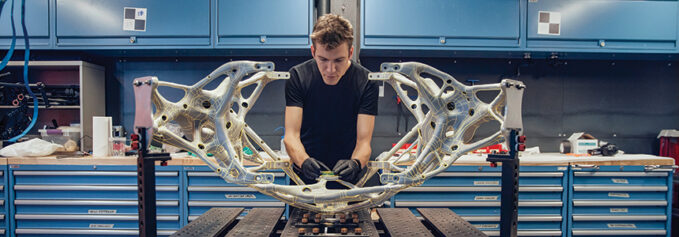
by Melissa Donovan
Manufacturers choose three-dimensional (3D) printing technologies for many reasons including the capability to easily create intricate parts, which may not be possible with more traditional manufacturing methods. Additive manufacturing (AM) also brings efficiency and ability to manufacture to scale.
Above: In this collaborative research project, Autodesk and NASA’s Jet Propulsion Laboratory tested the use of generative design to make a concept space lander that is 35 percent lighter than a traditional design. The software allowed the team to leverage three different manufacturing methods—casting, additive, and subtractive manufacturing—to produce the lightest and strongest design, which is critical for future space travel.
Combine AM with another influential technology—artificial intelligence (AI)—and the advantages double, even triple. “AM stands at the forefront of the fourth industrial revolution. Its alliance with AI marks a significant stride in the technological world, transforming everything from conceptual design to final inspection,” says Ed Tlegenov, senior manager, research science, Autodesk Inc.
Use It
AI is used in AM from design iterations to final results.
“Manufacturers are beginning to integrate various AI and machine learning (ML)-based algorithms into their 3D printing process in order to exploit the full potential of the technology. Applications of AI and ML can be found in prefabrication design, quality assurance and defect detection, material usage control, and predictive maintenance,” says Marcellus Buchheit, president/CEO, Wibu-Systems USA.
ML is a subset of AI. As Tlegenov explains it, “ML is where algorithms are designed to automatically learn and improve from experience without being explicitly programmed.”
If we look at how a part is manufactured via 3D printing, AI as well as ML is being used from end to end.
In the design phase, stable diffusion-type AI is leveraged for generating conceptual shapes and aiding in ideation, according Tlegenov. “This technology enables engineers to explore ideas before modeling, facilitating conceptual shape generation, and optimization specifically tailored for AM. Designers can explore a wider range of ideas with higher efficiency, making what was once impossible now within reach.”
“AI is used in optimization efforts related to component design and improved component performance. It is also used in the development of surrogate models to accurately predict complex AM build outcomes in near real time,” adds Dr. Rashid Miraj, director of technical operations, AlphaSTAR Technology Solutions, LLC.
Additionally, AI is leveraged in the simulation of AM parts. “Deep learning algorithms are deployed to enhance the simulation of AM parts. The application of neural networks to these graphics-heavy computations accelerates the process and significantly improves accuracy. It’s not just about quicker simulations; it’s about making them more reflective of real-world conditions,” explains Tlegenov.
During the actual printing process, AI is utilized. “From image recognition to real-time analysis of sensor data such as vibration, temperature, and acoustic emission, AI systems are actively engaged. They make on-the-fly adjustments, reduce errors, and enhance the quality of the build.
It’s a dynamic system that adapts and corrects as it creates,” comments Tlegenov.
During the final stages of AM, specifically scanning of the parts, Tlegenov also says AI is used. “When 3D scanning of AM parts hits hardware limitations, AI algorithms fill the gaps, enhancing resolution. The application of AI in this area ensures that even the minutest details are captured and analyzed.”
“The most obvious application in AM is process parameter optimization and anomaly detection. Here, AI and ML can supplement data analysis and, more significantly, data mining,” shares Miraj.
Concerning Things
While AI and its involvement in AM presents advantages, there are also challenges.
Similar to other verticals, AI brings up concerns, although Andre Wegner, CEO, Authentise, believes that “since the AM industry is a laggard in adopting the technology, these issues will be solved by more advanced industries before we’ve even managed to establish our use cases.”
For Miraj, the old refrain “garbage in, garbage out” still holds. “Good analysis and decision making is based on reliable data and accurate descriptions of experience to augment learning.”
“While AI’s integration with AM offers vast potential, current closed and rigid data formats pose challenges in terms of collaboration, efficiency, transparency, and accuracy. The adoption of open data formats and cloud solutions can play a pivotal role in addressing these issues,” admits Tlegenov.
According to Tlegenov, “open data formats encourage interoperability, allowing different systems to work together seamlessly, while cloud solutions offer scalability, real-time collaboration, and centralized control. Together, they present a pathway to a more cohesive, transparent, and efficient use of AI in AM, empowering industries to fully leverage the transformative potential of these technologies.”
AI and AM in the Future
We are at the beginning of how AI and AM work together. The future is bright.
“The level of sophistication depends on the application. Automation, interactive user interfaces, design optimization, and defect detection are just starting points. At some point, AI will address the entire process including justification for production and finished part material handling,” foresees Miraj.
Tlegenov details how AI will impact AM throughout the various stages of the process. For example, in design, intelligent design systems, material optimization, and generative design are all possible with AI.
“AI will likely develop systems that collaborate with human designers more intuitively; understanding the designer’s intent, requirements, and goals; then suggesting optimized designs based on real-world constraints,” comments Tlegenov.
Wegner agrees that the future includes more true AI approaches to design. “The fastest development in AI currently is around large language models, which are especially powerful in processing text prompts. Therefore, we’re going to see more true AI approaches to design, especially around the nexus of communicating intent into designs using natural language.”
During the 3D print process, AI will be used in smart factories, quality control automation, and sustainability. “AI could enable fully automated smart factories where entire AM processes are monitored, controlled, and optimized by intelligent systems. Advanced image recognition and real-time adjustment algorithms may completely automate quality control, ensuring higher consistency. AI may drive improvements in energy efficiency and recycling within the AM process, contributing to more sustainable manufacturing practices,” suggests Tlegenov.
“From design to production to inspection, AI technologies will likely drive significant advancements in efficiency, quality, complexity, and sustainability. The convergence of these technologies points to a future where the boundaries of what can be designed and manufactured continue to expand, fueling innovation across industries,” explains Tlegenov.
Paradigm Shift
As AM continues its infiltration of manufacturing, AI isn’t far behind. Both technologies are a powerhouse combination.
“The convergence of AI and AM is not just an advancement; it’s a paradigm shift. From design conceptualization to the final product inspection, AI is proving to be an invaluable asset, enriching every facet of the process. The alliance of these two technologies illustrates the future of manufacturing a future characterized by efficiency, precision, adaptability, and endless potential,” states Tlegenov.
At industrialprintmagazine.com learn more about AI and AM at industrialprintmagazine.com/webinars.
Oct2023, Industrial Print Magazine



